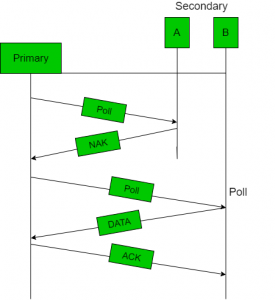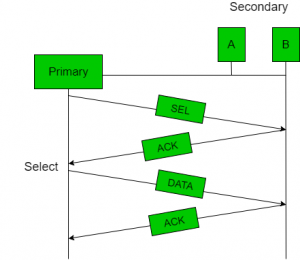Controlled Access Protocols in Computer Network
Last Updated :
14 Mar, 2023
In controlled access, the stations seek information from one another to find which station has the right to send. It allows only one node to send at a time, to avoid the collision of messages on a shared medium. The three controlled-access methods are:
- Reservation
- Polling
- Token Passing
Reservation
- In the reservation method, a station needs to make a reservation before sending data.
- The timeline has two kinds of periods:
- Reservation interval of fixed time length
- Data transmission period of variable frames.
- If there are M stations, the reservation interval is divided into M slots, and each station has one slot.
- Suppose if station 1 has a frame to send, it transmits 1 bit during the slot 1. No other station is allowed to transmit during this slot.
- In general, i th station may announce that it has a frame to send by inserting a 1 bit into i th slot. After all N slots have been checked, each station knows which stations wish to transmit.
- The stations which have reserved their slots transfer their frames in that order.
- After data transmission period, next reservation interval begins.
- Since everyone agrees on who goes next, there will never be any collisions.
The following figure shows a situation with five stations and a five-slot reservation frame. In the first interval, only stations 1, 3, and 4 have made reservations. In the second interval, only station 1 has made a reservation. 
Advantages of Reservation:
- The main advantage of reservation is high rates and low rates of data accessing time of the respective channel can be predicated easily. Here time and rates are fixed.
- Priorities can be set to provide speedier access from secondary.
- Predictable network performance: Reservation-based access methods can provide predictable network performance, which is important in applications where latency and jitter must be minimized, such as in real-time video or audio streaming.
- Reduced contention: Reservation-based access methods can reduce contention for network resources, as access to the network is pre-allocated based on reservation requests. This can improve network efficiency and reduce packet loss.
- Quality of Service (QoS) support: Reservation-based access methods can support QoS requirements, by providing different reservation types for different types of traffic, such as voice, video, or data. This can ensure that high-priority traffic is given preferential treatment over lower-priority traffic.
- Efficient use of bandwidth: Reservation-based access methods can enable more efficient use of available bandwidth, as they allow for time and frequency multiplexing of different reservation requests on the same channel.
- Support for multimedia applications: Reservation-based access methods are well-suited to support multimedia applications that require guaranteed network resources, such as bandwidth and latency, to ensure high-quality performance.
Disadvantages of Reservation:
- Highly trust on controlled dependability.
- Decrease in capacity and channel data rate under light loads; increase in turn-around time.
Polling
- Polling process is similar to the roll-call performed in class. Just like the teacher, a controller sends a message to each node in turn.
- In this, one acts as a primary station(controller) and the others are secondary stations. All data exchanges must be made through the controller.
- The message sent by the controller contains the address of the node being selected for granting access.
- Although all nodes receive the message the addressed one responds to it and sends data if any. If there is no data, usually a “poll reject”(NAK) message is sent back.
- Problems include high overhead of the polling messages and high dependence on the reliability of the controller.


Advantages of Polling:
- The maximum and minimum access time and data rates on the channel are fixed predictable.
- It has maximum efficiency.
- It has maximum bandwidth.
- No slot is wasted in polling.
- There is assignment of priority to ensure faster access from some secondary.
Disadvantages of Polling:
- It consume more time.
- Since every station has an equal chance of winning in every round, link sharing is biased.
- Only some station might run out of data to send.
- An increase in the turnaround time leads to a drop in the data rates of the channel under low loads.
Efficiency Let Tpoll be the time for polling and Tt be the time required for transmission of data. Then,
Efficiency = Tt/(Tt + Tpoll)
Token Passing
- In token passing scheme, the stations are connected logically to each other in form of ring and access to stations is governed by tokens.
- A token is a special bit pattern or a small message, which circulate from one station to the next in some predefined order.
- In Token ring, token is passed from one station to another adjacent station in the ring whereas incase of Token bus, each station uses the bus to send the token to the next station in some predefined order.
- In both cases, token represents permission to send. If a station has a frame queued for transmission when it receives the token, it can send that frame before it passes the token to the next station. If it has no queued frame, it passes the token simply.
- After sending a frame, each station must wait for all N stations (including itself) to send the token to their neighbours and the other N – 1 stations to send a frame, if they have one.
- There exists problems like duplication of token or token is lost or insertion of new station, removal of a station, which need be tackled for correct and reliable operation of this scheme.

Performance of token ring can be concluded by 2 parameters:-
- Delay, is a measure of time between when a packet is ready and when it is delivered. So, the average time (delay) required to send a token to the next station = a/N.
- Throughput, which is a measure of successful traffic.
Throughput, S = 1/(1 + a/N) for a<1
and
S = 1/{a(1 + 1/N)} for a>1.
where N = number of stations
a = Tp/Tt
(Tp = propagation delay and Tt = transmission delay)
Advantages of Token passing:
- It may now be applied with routers cabling and includes built-in debugging features like protective relay and auto reconfiguration.
- It provides good throughput when conditions of high load.
Disadvantages of Token passing:
- Its cost is expensive.
- Topology components are more expensive than those of other, more widely used standard.
- The hardware element of the token rings are designed to be tricky. This implies that you should choose on manufacture and use them exclusively.
Share your thoughts in the comments
Please Login to comment...